
Hakea salicifolia commonly known as the willow-leaved hakea, is species of flowering plant that is endemic to eastern Australia. It is an adaptable, fast growing small tree or shrub with attractive foliage and cream white flowers.
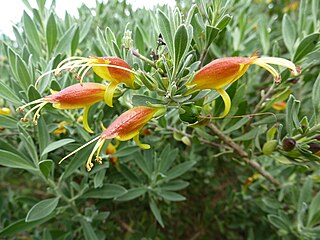
Eremophila glabra, commonly known as tar bush, is a plant in the figwort family, Scrophulariaceae and is endemic to Australia. It is sometimes a low, ground-hugging and sometimes an erect shrub. The leaves are variable in size and shape and there is a range of flower colours. In spite of its scientific name, not all forms of the plant are glabrous but most have many small, raised glands on the stems, flowers and leaves.

Anthocercis, commonly known as tailflower, is a genus of shrubs which are endemic to southern temperate Australia with the center of distribution in the South West Botanical Province of Western Australia. All species of Anthocercis contain tropane alkaloids, and have occasionally caused poisoning in children or been suspected of poisoning stock. Anthocercis is known as the only Solanaceous plant known to produce resin compounds on glandular trichomes.

Anthocercis viscosa, also known as sticky tailflower, is a species of shrub in the family Solanaceae, native to the south coast of Western Australia. It grows up to 3 metres in height and produces white or cream flowers between May and February in its native range.

Grevillea rhyolitica, commonly known as Deua grevillea or Deua flame, is a species of flowering plant in the family Proteaceae and is endemic to south-eastern New South Wales. It is a more or less erect shrub with elliptic leaves and hairy red flowers.

Olearia phlogopappa commonly known as the dusty daisy-bush or alpine daisy-bush is a species of flowering plant in the family Asteraceae that is commonly found in eastern New South Wales, Victoria and Tasmania. It is a small shrub with greyish-green foliage, daisy-like flowers in white, pink or mauve that can be seen from spring to late summer.

Hakea decurrens, commonly known as bushy needlewood, is a species of shrub or small tree in the family Proteaceae.
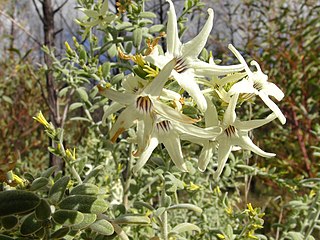
Cyphanthera is a genus of nine species of flowering plants in the family Solanaceae and are endemic to Australia.

Angophora bakeri, commonly known as the narrow-leaved apple, is a species of tree that is endemic to New South Wales. It has rough, fibrous bark on the trunk and branches, lance-shaped adult leaves, flower buds in groups of three or seven, white or creamy white flowers and oval to cylindrical fruit.

Grevillea oxyantha is a species of flowering plant in the family Proteaceae and is endemic to south-eastern continental Australia. It is an erect to spreading shrub with somewhat silky-hairy branchlets, broadly elliptic to broadly egg-shaped or almost round leaves, and hairy, crimson and pink flowers with a red style.
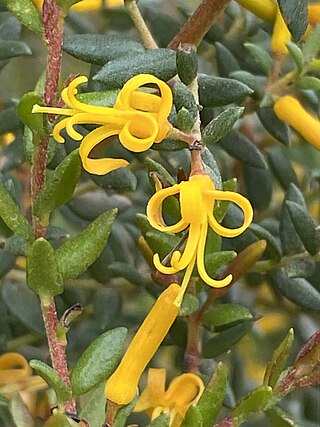
Persoonia mollis, commonly known as soft geebung, is a plant in the family Proteaceae and is endemic to New South Wales. It is an erect to prostrate shrub with linear to oblong or spatula-shaped leaves, yellow flowers in groups of up to thirty on a rachis up to 150 mm (5.9 in) long and relatively small fruit.
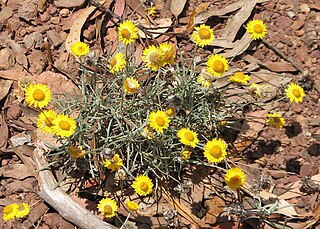
Leucochrysum albicans, commonly known as hoary sunray, is a flowering plant in the family Asteraceae. It is a small perennial with grey leaves, white or yellow flower-heads and is endemic to Australia.

Lissanthe strigosa, commonly known as peach heath, is a species of flowering plant in the family Ericaceae, and is endemic to south-eastern Australia. It is a shrub with linear to lance-shaped leaves and white to pink, cylindrical flowers.
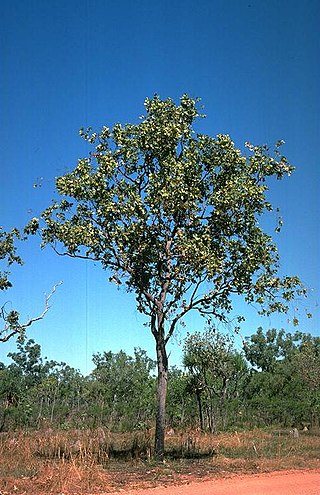
Corymbia ferruginea, commonly known as rusty bloodwood, is a species of tree that is endemic to northern Australia. It has rough, tessellated bark on the trunk and branches, a crown of sessile juvenile leaves, flower buds in groups of three or seven, pale creamy yellow flowers and urn-shaped fruit.

Goodenia heterophylla is a species of plant in the family Goodeniaceae and is endemic to eastern Australia. It is an erect to trailing, more or less woody herb or shrub with linear to egg-shaped stem-leaves and racemes or thyrses of yellow flowers.
Hakea leucoptera subsp. sericipes is a small tree with cylinder-shaped leaves and clusters of up to forty-five white fragrant flowers. It is found in northwestern New South Wales, Queensland and Western Australia.

Asterolasia rupestris is a species of erect shrub that is endemic to New South Wales. It has heart-shaped to triangular leaves with the narrower end towards the base, and densely covered with star-shaped hairs. The flowers are yellow and arranged singly or in groups of three to six in leaf axils or on the ends of branchlets, the back of the petals densely covered with rust-coloured, star-shaped hairs.

Goodenia bellidifolia, commonly known as daisy goodenia, is a species of flowering plant in the family Goodeniaceae and is endemic to eastern Australia. It is an erect, perennial herb with egg-shaped to lance-shaped leaves with the narrower end towards the base, spikes or thyrses of lemon-yellow to orange flowers, and oval to more or less spherical fruit.
Hibbertia echiifolia is a species of flowering plant in the family Dilleniaceae and is endemic to northern Australia. It is a variable shrub with elliptic to lance-shaped or oblong leaves and yellow flowers arranged singly in leaf axils, with twenty-nine to forty-five stamens arranged around the three carpels.
Hibbertia fractiflexa is a species of flowering plant in the family Dilleniaceae and is endemic to the Northern Territory. It is a small, multi-stemmed shrub with hairy foliage, elliptic leaves, and yellow flowers arranged in leaf axils with sixteen to twenty-two stamens arranged in groups around the two carpels.
















